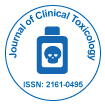
Journal of Clinical Toxicology
Open Access
ISSN: 2161-0495

ISSN: 2161-0495
Debjani Nath
Scientific Tracks Abstracts: J Clin Toxicol
To develop a toxicokinetic model of acute myelolytic leukemia, benzene was used as a potent leukemogenic agent. The dose,
period and time of cumulative benzene exposure of Swiss Albino mice were optimized and survival rate; alteration in cell cycle
regulation and other clinical manifestations were analyzed at a cumulative dose of 300 ppm × 6 hr./day × 5 days/week for 2 weeks,
i.e., 9000 (a) ppm. Analyzing physiological parameters like plasma enzyme profile, complete hematology (Hb%, RBC indices and
WBC differentials), hematopoietic cells morphology, expression of cell cycle regulatory proteins, tissue histology and analysis of
DNA fragmentation, optimum conditions were established. Elevated level of Plasma AST/ALT with corresponding changes in liver
histology of optimally exposed animals also confirmed the toxicokinetic relation of benzene with leukemia. Down regulation of p53
and p21 and up regulation of CDK2, CDK4, CDK6, cyclin D1 and E in this exposed group were marked as the optimum conditions of
cellular deregulation for the development of secondary AML. The efficacy of this in vivo model has been tested for chemopreventive
activity of two natural phytochemicals like catechin a natural phenol and antioxidant from Saraca asoca (Roxb.) and monotarpenes
from Ocimum basilicum L. comparing with known chemotherapeutic drug doxorubicin. It has been concluded that this toxicokinetic
model can be utilized as a testing template for the development of multiactive drugs for cancer chemoprevention in the near future.
Debjani Nath completed her PhD from Jadavpur University on 1998 and pursued her research endeavor as Postdoctoral fellow from Indian Institute of Chemical Biology,
India. She has completed her teaching career of fifteen years in University of Kalyani, India and published several papers in international journals of repute and is serving
as the Editorial Board Member of four international publications.